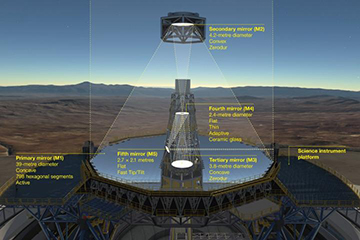Under the ELT five-mirror design, a segmented 39-m primary concave mirror captures light, which bounces off a 4.2-m secondary mirror and a 3.8-m tertiary mirror. Flat fourth and fifth mirrors, part of the scope’s adaptive-optics system, complete the array. On Wednesday, ESO announced major contract on the secondary and tertiary mirrors and associated optics and controls. [Image: ESO] [Enlarge image]
The European Southern Observatory (ESO) marked another milestone toward construction of the largest optical/near-infrared telescope ever built. On 18 January, the organization signed four contracts, all with companies from ESO member states, that will build a number of key optical components for the European Extremely Large Telescope (ELT).
The ELT—now under construction around 20 km away from ESO’s existing Very Large Telescope in Paranal, Chile—is slated for first light in 2024. The component contracts announced on Wednesday include the planned telescope’s huge secondary and tertiary mirrors, the active-optics systems to support them, and the array of sensors that will control the shape of the telescope’s vast, segmented 39-m primary mirror to nanometer-scale precision.
Schott gets mirror deals
While the contract to manufacture the scope’s primary mirror remains to be let, ESO announced that the casting of the substrates for the 4.2-m convex secondary mirror and the 3.8-m concave tertiary mirror would go to the German company Schott. Both mirrors rival in size the primary mirrors of most Earth-based telescopes; the secondary mirror in particular will be the largest convex mirror ever produced.
Both mirror substrates will be cast using Schott’s Zerodur glass-ceramic material—which, according to the company, has the advantage of “an extremely low thermal expansion coefficient,” to maintain shape amid temperature fluctuations. The company also notes that Zerodur is “chemically resistant and easily polished.” (The contract for actually polishing the secondary mirror was awarded last June, to the French company Reosc.)
Schott—which has already, in 2016, shipped the substrates for a 2.4-m segmented mirror related to the ELT’s adaptive-optics system—expects to deliver the secondary-mirror substrate to the ELT construction site in Chile by year-end 2018, with the tertiary-mirror substrate to follow by July 2019.
Active optics and sensor grids
The other two contracts announced on Wednesday dealt with the components that will ensure that the ELT’s behemoth mirrors behave themselves.
The Sener Group, a Spanish/Polish engineering firm, secured an agreement to design and build the complex support cells and active optical elements required to align the secondary and tertiary mirrors and to correct for surface errors, to a precision of tens of nanometers. And a consortium consisting of the French firm Fogale Nanotech and the German company Micro-Epsilon won a contract for fabricating some 4,608 edge sensors to control the shape of the 798 hexagonal segments constituting the telescope’s 39-m primary mirror.
A telescope of superlatives
ESO, in a rather breathless press release accompanying the announcement, stressed the ELT’s unprecedented scale, noting that the scope’s complex, five-mirror design will require “optics and mechanical elements that stretch modern technology to its limits.” The primary and secondary mirrors, for example, will weigh in at 3.5 and 3.2 metric tons. Fabrication of the highly convex, huge, aspheric secondary mirror will be “a genuine first,” in ESO’s words. And the sensors to be delivered by the Fogale/Micro-Epsilon partnership will need to be, according to ESO, “the most accurate ever used in a telescope,” capable of few-nanometer precision.
At the signing ceremony, ESO Director General Tim de Zeeuw also gave a nod to the project’s European roots, stressing that the work had been awarded to “three leading industrial partners from our Member States.” No information was released, however, on the actual value of the contracts in Euros.

